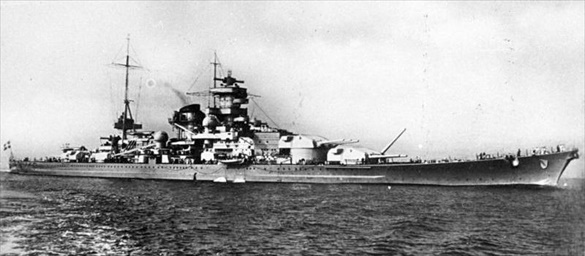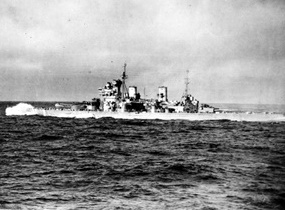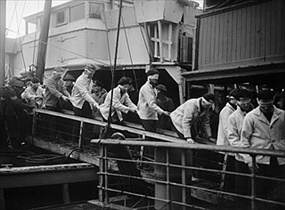BRITISH TRAP ENDS SCHARNHORST’S CAREER
North Cape, Norway • December 26, 1943
On this date, the day after Christmas 1943, the German battleship (aka battlecruiser) Scharnhorst and her crew of 1,968 met their fate in the Battle of the North Cape off the northern tip of Norway. At 32,100 long tons, the sleek, 771‑foot/235‑meter state-of-the-art warship fitted out with 9 11‑inch/28‑centimeter guns was laid down in 1935, christened in October 1936, and commissioned into the Kriegsmarine (German fleet) in early 1939. In late November of that year, less than 3 months after the European War broke out over Germany’s invasion of Poland, Scharnhorst, along with her identical sister ship Gneisenau, embarked on her first wartime patrol. Sinking a British auxiliary cruiser in a short battle, the greenhorn commerce raiders escaped a British task force sent after them, arriving safely back in Wilhelmshaven, Germany’s main military port, on November 27, 1939.
Although fate smiled on the crew of the German warship in November 1939 and again in February 1941 and 12 months later, it was nevertheless fickle. When Scharnhorst was first being assembled in dry dock at Wilhelmshaven Naval Shipyard in 1935, her supporting timbers abruptly gave way and the hull rolled onto her side. Sixty-one workers were killed and 110 injured. Three months passed before the hull was righted. Then, the night before the vessel was to be launched, her mooring lines snapped and she slid into the crowded Kiel harbor and smashed into 2 barges anchored in her path. On the flip side, Scharnhorst and Gneisenau earned kudos from German Chancellor Adolf Hitler and Adm. Erich Raeder for sinking 21 Allied supply and merchant ships totaling 115,622 tons and capturing 1 vessel between January and March 1941. The 2 commerce raiders used their superior speed to avoid a British task force bent on their destruction, arriving on March 22 in the German-occupied French port of Brest in Brittany, the peninsula that protrudes westward into the Atlantic Ocean. There Scharnhorst underwent engine repairs and both warships underwent further repairs after suffering extensive bomb damage from a revengeful Royal Air Force. Nearly a year later, on February 11–13, 1942, in heavy fog but under lucky stars, the sister battlewagons and their escorts successfully pulled off a high-risk, daylight dash from Brest up the English Channel to safety in Northern Germany, escaping destruction by British air and naval forces (bombers, torpedo planes, destroyers, and torpedo boats), though in Scharnhorst’s case incurring damage by striking 2 of the thousands of mines planted by both adversaries throughout the Channel and European estuaries.
On December 25, 1943, Scharnhorst steamed out of her anchorage in Alta Fjord (Altafjord) in Norway’s Far North. Alta Fjord was an anchorage from which the Kriegsmarine dispatched raiding parties like Scharnhorst’s to interdict inbound and outbound Allied convoys that delivered essential supplies to the Soviet Union’s northern ports. The Royal Navy baited Rear Adm. Erich Bey, who commanded Scharnhorst, with Soviet-bound Arctic convoy JW 55B, consisting of 19 cargo vessels escorted by 10 destroyers. The next day, December 26, as Scharnhorst and her destroyer escorts searched out the convoy in poor weather and rough seas, 2 British cruisers detected the battleship off Norway’s Nordkapp (North Cape). One of 2 8‑inch/20‑centimeter shells took out Scharnhorst’s forward radar, but the superior speed of the battleship permitted her escape—and into the trap the British were laying. Just before 5:00 p.m. a British cruiser used parachute flares to illuminate Scharnhorst, now absent her escorts, and, from 6.8 miles/10,900 meters away, the British battleship HMS Duke of York opened fire with her 14‑inch/36‑centimeter cannons. Additional shellfire and torpedo hits from Duke of York and British and Norwegian warships pulverized Scharnhorst. At 7:45 p.m. the German battleship turned propeller up and slid under the surface. Just 36 sailors out of 1,968 aboard Scharnhorst survived the harrowing sinking.
Transatlantic Commerce Nightmare: German Battleship Scharnhorst
 |
Above: German battleship (Schlachtschiff) Scharnhorst at anchor sometime before August 1939, when her straight stem, low bow was replaced by a concave “Atlantic bow.” Two months later the warship was fully operational. With triple steam turbines and triple 3‑bladed propellers nearly 16‑foot/4.8‑meter in diameter, Scharnhorst could outrun any pursuing British capital ship sent against her. At a cruising speed of 19 knots/22 mph/35.4 km/h, the warship had a maximum range of 7,100 nautical miles/8,200 miles/13,196 km; her sister ship, Gneisenau, had a reduced maximum range of 6,200 nautical miles/7,135 miles/11,483 km. Enabling Scharnhorst’s renown speed were her smaller naval guns, 9 11‑inch/28‑centimeter quick-firing guns (3.5 rounds per minute) in 3 750‑ton triple turrets, 2 forward and a lone turret aft (see photo), compared with the newest and heavier British battleships with their 14‑inch/36 centimeter guns. The massive British armor-piercing shells (1,590 lb./721 kg) made for a deadlier impact farther from their target. Scharnhorst’s main turret shells weighed between 727 lb./330 kg and 694 lb./315 kg depending on type. Her secondary armament consisted of 12 5.9‑inch/15‑centimeter quick-firing guns mounted in 4 twin turrets and 4 pedestal mounts. There were also anti-aircraft batteries. In addition, Scharnhorst had 6 21‑inch/53.3‑centimeter deck-mounted torpedo tubes and 18 torpedoes after 1942 as well as 3 Arado Ar 196 catapult-launched reconnaissance floatplanes. Scharnhorst had a crew of between 56 to 60 officers and 1,613 to 1,780 enlisted men.
 |  |
Left: Waves crash over the bow of HMS Duke of York as the powerful new British battleship (launched 1940) steams at 20–25 knots/23–28.7 mph during Arctic convoy PQ 12 from Reykjavik, Iceland, to Murmansk in the Soviet Union. No ships were lost to the enemy in this outbound convoy, although the Bismarck-class battleship Tirpitz (15‑inch/38‑centimeter guns in 4 twin turrets) and 3 escorting destroyers were intent on wreaking havoc on PQ 12. From August 1941 to May 1945, with 2 interruptions, 78 Arctic convoys consisting of some 1,400 merchant ships escorted by aircraft and warships of the British Royal Navy, Royal Canadian Navy, and the U.S. Navy provided valuable military equipment and other supplies for the Soviet war effort against Nazi Germany. Scharnhorst and Tirpitz forced the British to retain significant air and naval forces in the region to contain the 2 commerce raiding battleships. (Other dangers took the form of the battleship Gneisenau, the pocket battleship Luetzow, and heavy cruisers Prince Eugen, Admiral Hipper, and Admiral Scheer.) Scharnhorst was sunk by the Royal Navy in a night action on December 26, 1943, off Norway’s North Cape, and Tirpitz was sunk by the Royal Air Force using bunker-busting Tallboys on November 12, 1944, at her anchorage near the Norwegian city of Tromsø.
![]()
Right: Toward the end of the day, December 26, 1943, HMS Duke of York had scored several direct hits on her German prey, Scharnhorst, using her 10 14‑inch/36‑centimeter guns. Duke of York’s first salvo disabled Scharnhorst’s forward-most (A) turret. Another shell detonated in the No. 1 boiler room, causing the heavy warship to limp ahead at 8 knots/9.2 mph/14.8 km/h. Sensing his ship’s end, Adm. Bey radioed Fleet Command: “We will fight on until the last shell is fired.” Less than a half hour later, British and Norwegian destroyers had caught up with Scharnhorst, pouring shells and torpedoes into the stricken ship. At 7:00 p.m., from 5.9 miles/9,500 meters away, Duke of York lobbed more salvos into the dying enemy. A round of 19 torpedoes finally sank Scharnhorst shortly before 8 p.m. Thirty-six survivors, shown blindfolded disembarking at Britain’s Scapa Flow naval base in Scotland on January 2, 1944, were plucked from the frigid water before British ships were ordered away, even while shipwreck men could be heard crying out for rescue.
Documentary Featuring the Career of the German Battleship Scharnhorst
![]()

 History buffs, there is good news! The Daily Chronicles of World War II is now available as an ebook for $4.99 on Amazon.com. Containing a year’s worth of dated entries from this website, the ebook brings the story of this tumultuous era to life in a compelling, authoritative, and succinct manner. Featuring inventive navigation aids, the ebook enables readers to instantly move forward or backward by month and date to different dated entries. Simple and elegant! Click
History buffs, there is good news! The Daily Chronicles of World War II is now available as an ebook for $4.99 on Amazon.com. Containing a year’s worth of dated entries from this website, the ebook brings the story of this tumultuous era to life in a compelling, authoritative, and succinct manner. Featuring inventive navigation aids, the ebook enables readers to instantly move forward or backward by month and date to different dated entries. Simple and elegant! Click 











